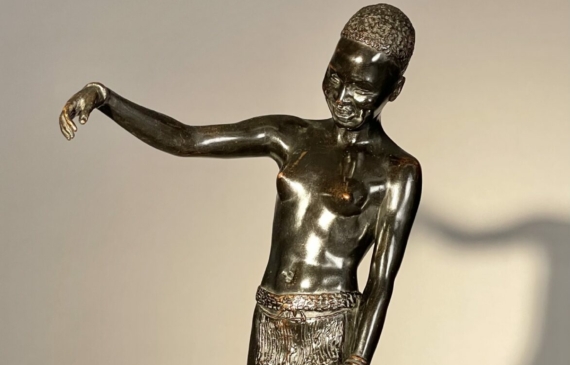


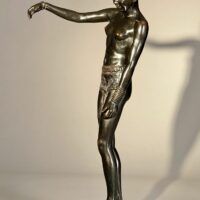
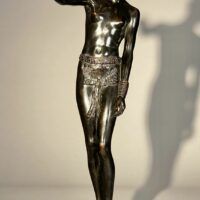
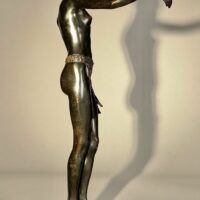

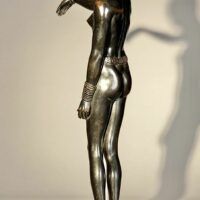
Malvina Hoffman
American, 1887 – 1966
Daboa, c. 1930
Bronze, dark brown patina
21 1/2 H. x 7 5/8 W. x 9 5/8 D. inches
Signed and titled on base: DABOA / MALVINA HOFFMAN / ©
Inscribed on base: CELLINI BRONZE WORKS N.Y-
Mounted to original wood base, 1 3/8 H. inches
Overall height: 23 inches
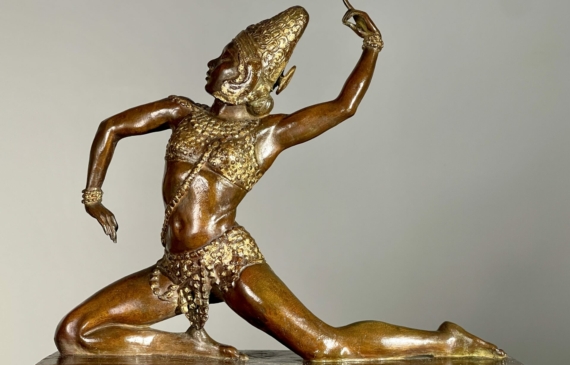
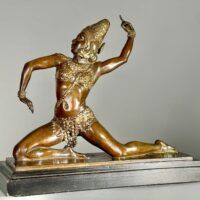

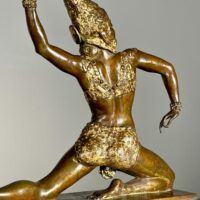
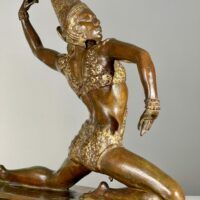
Malvina Hoffman (American, 1885-1966)
Dance of Parvati, Nyota Inyoka, 1932
Bronze, 10 ½ H. x 12 ⅞ W. x 3 ¾ D. inches
Brown patina with gilded accents
Signed on base: © MALVINA HOFFMAN 1932
Stamped on base: C. Valsuani / Cire Perdue / PARIS
Mounted on original painted wood base
PRIVATE COLLECTION
Malvina Hoffman, an American sculptor known for her life-size bronze sculptures of people, was born in New York City in 1885, the fourth of six children. Drawing to the visual arts from an early age, Hoffman took evening classes at the Woman’s School for Applied Design and the Art Students League of New York. In 1906, Hoffman studied painting with John White Alexander and Harper Pennington. She later built her skills in sculpture studying with artists such as Gutzon Borglum, while working as Alexander Phimister Proctor’s assistant in 1907 at his MacDougal Street studio in Greenwich Village. She traveled to Paris the following year with Katharine Rhoades and Marion H. Beckett to study art. She completed her first sculpture, a bust of her father, in 1909, just two weeks before his death. The following year, it was exhibited at the National Academy.
After her father’s death, Hoffman moved to Europe with her mother in 1910. Stopping in London, she saw a performance of the Baccanale, a ballet choreographed to the autumn section of The Seasons by Aleksandr Glazunov danced by Anna Pavlova and Mikhail Mordkin, who modeled for her two years later in poses from the beginning of the ballet in her sculpture Bacchanale Russe, which won the National Academy’s Julia A. Show Memorial Prize in 1917. Settling in Paris later that year, Hoffman worked as a studio assistant to Janet Scudder. After five failed attempts, she was accepted as a student of Auguste Rodin, who advised her to be unafraid of realism. She resided in Paris until the outbreak of World War I in 1914, then returned to New York.
Hoffman played a key role in organizing the French war charity Appui aux Artistes and the American-Yugoslav relief fund for children. She served in the Red Cross during both WWI and WWII and earned awards in public service including the French Legion of Honour and the Royal Order of St. Sava III of Yugoslavia. She also sculpted Serbian Colonel Milan Pribicevic in 1916 in A Modern Crusader, which can be seen at the Metropolitan Museum of Art, the Smithsonian American Art Museum, and the Art Institute of Chicago.
In 1929, Hoffman was commissioned by the Field Museum of Natural History in Chicago, Illinois to travel the world and create sculptures of people of different ethnicities across the globe. In what may have been the largest commission ever given to any sculptor at the time, Hoffman traveled to countries such as Sudan, India, and Indonesia, and completed over 105 sculptures, mostly in bronze but also in marble and stone, and busts as well as full-length figures. The exhibit opened in 1933 and was quite popular, staying open until 1969. In 2016, 50 sculptures from the collection were included in a new exhibition at the Field Museum titled “Looking at Ourselves: Rethinking the Sculptures of Malvina Hoffman”.
Hoffman has received awards such as the 1924 gold medal from the National Academy, the 1962 gold medal of honor from the Allied Artists of America for her piece Mongolian Archer, and the 1964 gold medal of honor from the National Sculpture Society. She was also awarded five honorary doctorates. Her work is in the permanent collections of museums such as the Metropolitan Museum of Art, the Smithsonian American Art Museum, the Detroit Institute of Arts, the Santa Barbara Museum of Art, the Dallas Museum of Art, and the Harvard Art Museums.